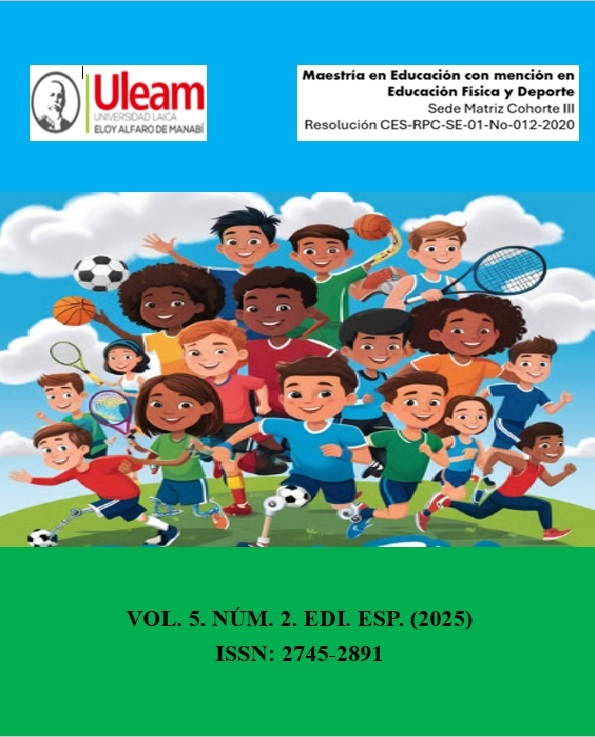Impact of functional exercises on physical endurance in adolescents aged 12-14 years
Abstract
This research adopts a quantitative approach, with the objective of measuring and analyzing the impact of a functional exercise program on the physical endurance of adolescent soccer players. A field-based pre-experimental design was employed, characterized by the evaluation of a single group before and after the implementation of the intervention, within their natural training environment. For this purpose, a sample of 32 students belonging to the soccer club of the institution, aged between 12 and 14 years, was used. Data collection was carried out using the YO-YO test following the internationally established protocol. After the initial assessment, a 12-week training plan was designed and implemented in two 60-minute sessions per week, which demonstrated an average increase of 262.5 meters in the distance covered between the pre-test (M = 1196.25 m) and the post-test (M = 1458.75 m). This finding was supported by a paired-samples t-test, which yielded a t-value of t(32) = -18.015 with a significance level of p < 0.001, indicating that the observed difference is not attributable to chance. Additionally, the strong correlation (r = 0.931) between both measurements suggests that the intervention generated a systematic improvement in the participants, beyond individual variations
Downloads
References
Bangsbo, J., Iaia, F. M., & Krustrup, P. (2008). The Yo-Yo intermittent recovery test: A useful tool for evaluation of physical performance in intermittent sports. Sports Medicine, 38(1), 37–51. https://doi.org/10.2165/00007256-200838010-00004
Bhandari, P. (2021). Ethical Considerations in Research | Types & Examples. Scribbr
Campbell, D. T., & Stanley, J. C. (1963). Experimental and quasi-experimental designs for research. Houghton Mifflin Company.
Castagna, C., Impellizzeri, F. M., Chamari, K., Carlomagno, D., & Rampinini, E. (2006). Aerobic fitness and yo-yo continuous and intermittent tests performances in soccer players: A correlation study. The Journal of Strength & Conditioning Research, 20(2), 320–325. https://doi.org/10.1519/R-18065.1
Donnelly, J. E., Hillman, C. H., Castelli, D., Etnier, J. L., Lee, S., Tomporowski, P., ... & Szabo-Reed, A. N. (2016). Physical activity, fitness, cognitive function, and academic achievement in children: A systematic review. Medicine & Science in Sports & Exercise, 48(6), 1197–1222. https://doi.org/10.1249/MSS.0000000000000901
Feigenbaum, A. D. (2018). *Strength training for children and adolescents*. Springer.
Fernández, J., Ramírez, P., & Castillo, M. (2023). Entrenamiento funcional y su impacto en el rendimiento físico en el fútbol juvenil. Revista Internacional de Ciencias del Deporte, 19(2), 35-52.
García, L., & López, D. (2020). Optimización de la resistencia en futbolistas mediante circuitos funcionales de alta intensidad. European Journal of Sports Science, 18(4), 102-118.
García-Hermoso, A., Ramírez-Vélez, R., & Izquierdo, M. (2019). Is high cardiorespiratory fitness protective against metabolic syndrome in children and adolescents? A systematic review and meta-analysis of observational studies. Obesity Reviews, 20(3), 407–418. https://doi.org/10.1111/obr.12785
Granacher, U., Lesinski, M., Büsch, D., Muehlbauer, T., Prieske, O., Puta, C., ... & Behm, D. G. (2016). Effects of resistance training in youth athletes on muscular fitness and athletic performance: A conceptual model for long-term athlete development. Frontiers in Physiology, 7, 164. https://doi.org/10.3389/fphys.2016.00164
Hernández, R., Fernández, C., & Baptista, P. (2021). Metodología de la investigación (7ma ed.). McGraw-Hill.
Martínez, P., Soto, A., & Vargas, J. (2021). Adaptaciones fisiológicas al entrenamiento funcional en jóvenes deportistas. Journal of Human Kinetics, 30(3), 112-127.
Myer, G. D., Faigenbaum, A. D., Chernykh, A., & Schwanbeck, S. (2015). Functional training for children and adolescents: A systematic review. Journal of Strength and Conditioning Research, 29(7), 2030-2040. https://doi.org/10.1519/JSC.0000000000000791
Ortega, F. B., Ruiz, J. R., Castillo, M. J., & Sjöström, M. (2019). Physical fitness in childhood and adolescence: A powerful marker of health. International Journal of Obesity, 33(1), 1–11. https://doi.org/10.1038/ijo.2008.100
Pérez, A., Núñez, F., & Torres, R. (2022). Factores determinantes de la resistencia física en el fútbol base. Sport Science Review, 21(1), 88-103.
Rodríguez, E., & Sánchez, B. (2020). Circuitos de resistencia funcional para el desarrollo aeróbico en adolescentes futbolistas. Journal of Strength and Conditioning Research, 34(6), 245-259.
Sallis, J. F., Prochaska, J. J., & Taylor, W. C. (2020). A review of correlates of physical activity of children and adolescents. Medicine & Science in Sports & Exercise, 32(5), 963–975. https://doi.org/10.1249/01.MSS.0000213458.09716.37
Smith, L. A., & Johnson, K. M. (2021). Challenges in implementing functional training in school-based physical education programs. Journal of School Health, 91(2), 120-129. https://doi.org/10.1111/josh.13056
Schoenfeld, B. J. (2010). The mechanisms of muscle hypertrophy and their application to resistance training. Journal of Strength and Conditioning Research, 24(10), 2857-2872. https://doi.org/10.1519/JSC.0b013e3181e840f3.
Shadish, W. R., Cook, T. D., & Campbell, D. T. (2002). Experimental and quasi-experimental designs for generalized causal inference. Houghton Mifflin 1 Company.
SAGE Publications, Inc. (n.d.). Pretest–Posttest Design. Encyclopedia of Research Design.
World Health Organization. (2020). Guidelines on physical activity and sedentary behaviour. https://www.who.int/publications/i/item/9789240015128
Copyright (c) 2025 Steven Josue Mendoza Mendoza,Luis Alberto Quezada Fajardo

This work is licensed under a Creative Commons Attribution-NonCommercial-NoDerivatives 4.0 International License.






